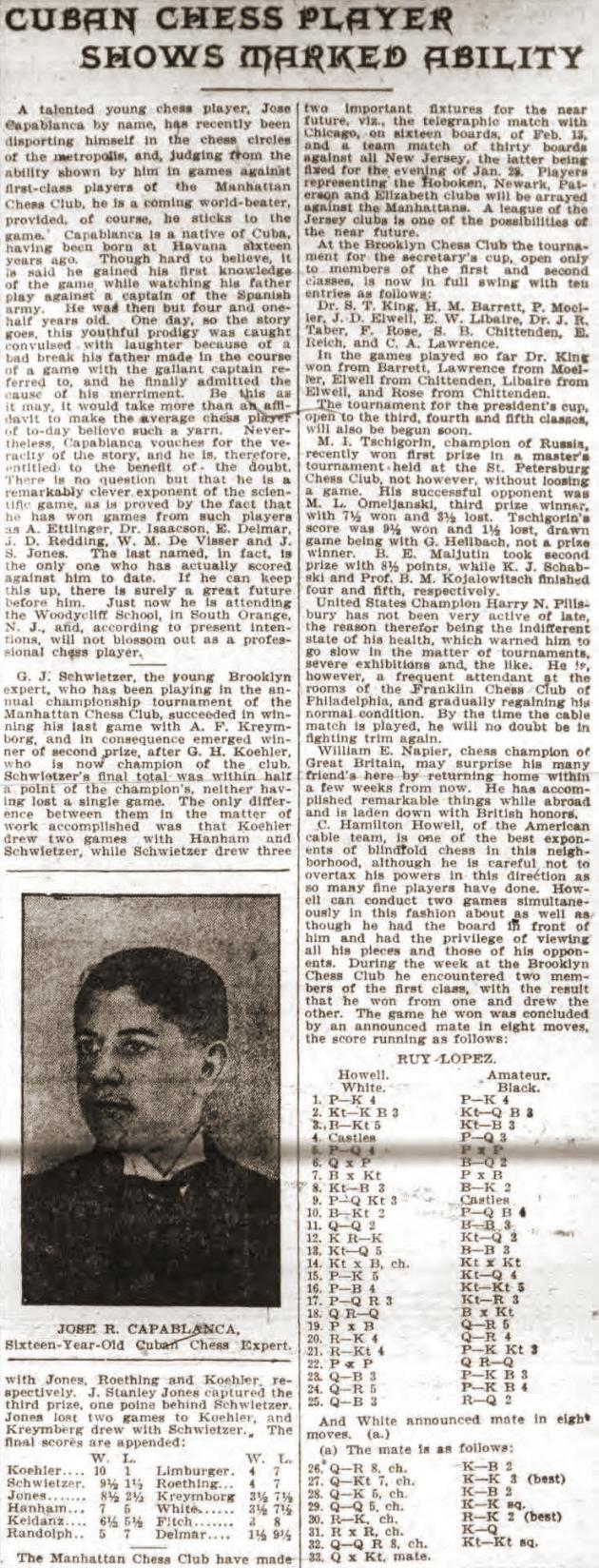
Edward Winter
Eduardo Bauzá Mercére (New York, NY, USA) forwards a report from the Brooklyn Standard-Union, 15 January 1905, page 6:

Later that year the photograph of Capablanca was published on page 126 of The Rice Gambit edited by H. Keidanz (an American Chess Bulletin Souvenir Supplement).
(8244)
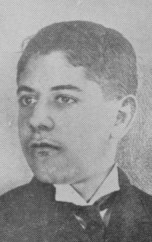
American Chess Bulletin, February 1905, page 126
From page 18 of the Texas newspaper El Paso Herald, 29 December 1906:
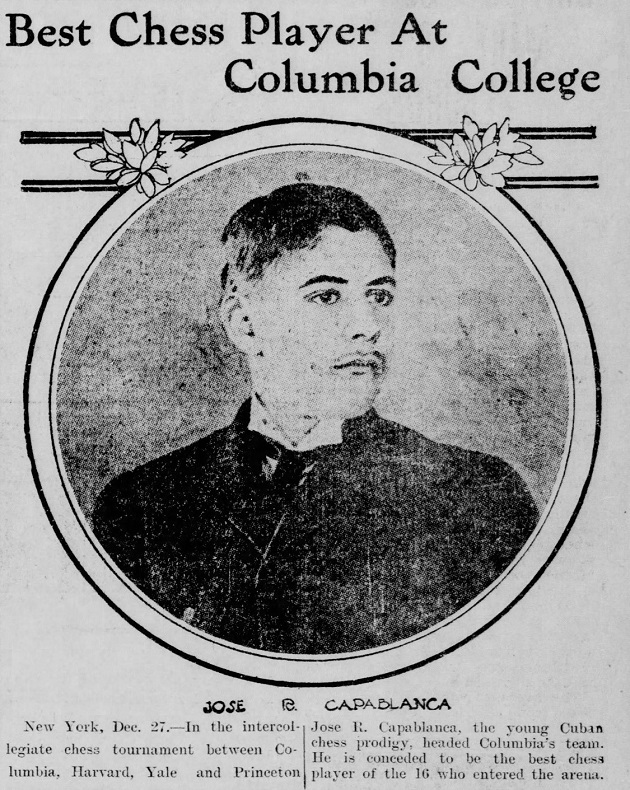
(9263)
This photograph (with Capablanca, the adjudicator, seated on the left) was given on page 46 of the March 1906 American Chess Bulletin:
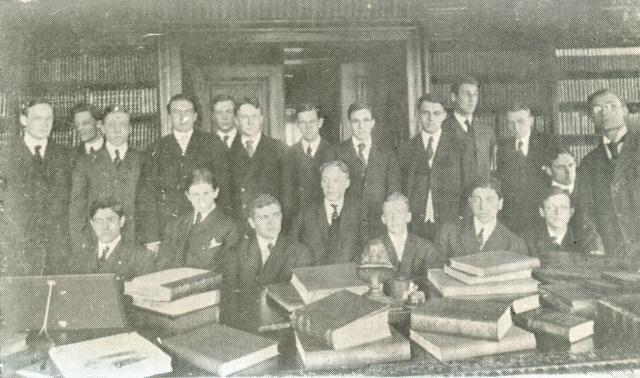
‘Participants in the Intercollegiate Match on ten boards, photographed in the library of the Villa Julia, New York, 3 March 1906’
For further details see Professor Isaac Rice and the Rice Gambit. See too C.N. 5879.
We are grateful to Ed Tassinari (Scarsdale, NY, USA) for information about Capablanca’s involvement with chess at Columbia University. Our correspondent has been through the Spectator, the university’s daily newspaper, from autumn 1906 to spring 1908. To mention just one report, the 11 December 1906 issue related that in a 30-seconds-per-move tournament the previous evening the Cuban finished first in a field of eight, defeating W. Koo, O. Brown and, in the final round, L.J. Wolff.
(2262)
From Chess and Baseball:
In an article by Capablanca, ‘How I Learned to Play Chess’, on pages 94-96 of Munsey’s Magazine, October 1916:
‘As a matter of fact, I cherish as one of my special accomplishments my more than ordinary ability in that very mundane but good American game of baseball. Such a thing, surely, must be foreign to genius!’
As reported on page 71 of our book on the Cuban, the November 1913 American Chess Bulletin, page 71, quoted comments he made to the magazine:
‘I am afraid that I shall miss my baseball and tennis while in Russia, but I shall try to become proficient in some other outdoor sports like horseback riding, etc. Or I may take up fencing and gymnasium work. I thoroughly believe in keeping in good trim physically.’
On page 20 we wrote:
‘... La Discusión (23 August [1909], page 8) reported on another speciality of Capablanca’s; in an Amateur Baseball Championship match between teams from Vedado and Marianao “Capablanca at shortstop made two splendid catches”. Later, when he was up at bat, the umpire had just called one strike against him when rain stopped play.’
The photograph below was on page 209 of Chess Facts and Fables, from C.N.s 3250 and 3258, and appeared, in larger format, in C.N. 5108:
Source: The Columbian 1909, page 140. Capablanca is standing third from the left:
[As mentioned in C.N. 6378, on page 65 of the same edition of The Columbian was devoted to the Columbia Chess Club and listed Capablanca as the ‘Varsity Team Captain’.]
A further photograph of Capablanca is reproduced here, with the permission of the editor, Frank Brady (New York, NY, USA), from page 20 of Chessworld, May-June 1964:
In response to a query from George DeRise (Hampton, VA, USA) about Capablanca’s education in the United States we provide a brief summary of the information on pages 10-12 of our monograph on the Cuban, supplemented by illustrations and some further material.
In 1904 Capablanca entered Woodycliff School in South Orange, NJ. The Principal, William Julius Eckoff (1853-1908), was a distinguished educator and author, as is shown by his entry in Who Was Who in America, 1897-1942, page 357:
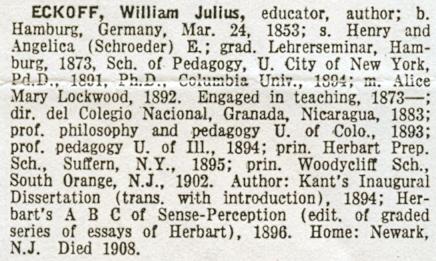
In C.N. 3333 we added that in 1906 Capablanca was attending Groff School, 228 W 72 Street, New York. This was shown by a letter he wrote to his mother on 22 April 1906:
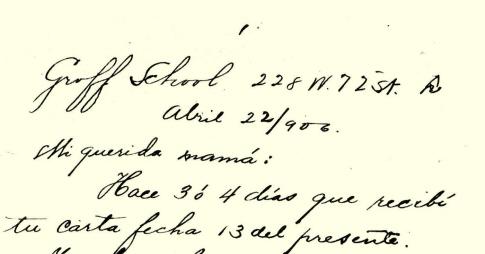
For a full English translation, see below (C.N. 3333). Since discovery of the letter, only one contemporary reference to the school has been found, an entry in the New York City Directory, 1906-07 (referring to Joseph Groff):
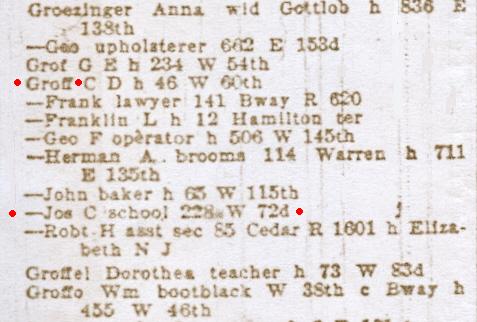
Capablanca’s university record (he was a non-graduate in engineering in the Class of 1910, although we are not sure exactly when the course was broken off) is mentioned on page 134 of the Columbia University Alumni Register 1754-1931 (New York, 1932):
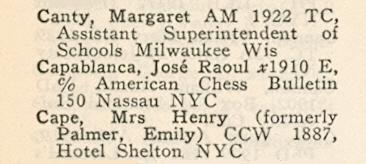
Columbia University holds his alumni information card, which gives his address as Calle 17 No. 512 entre 14716 Vedado, Havana:
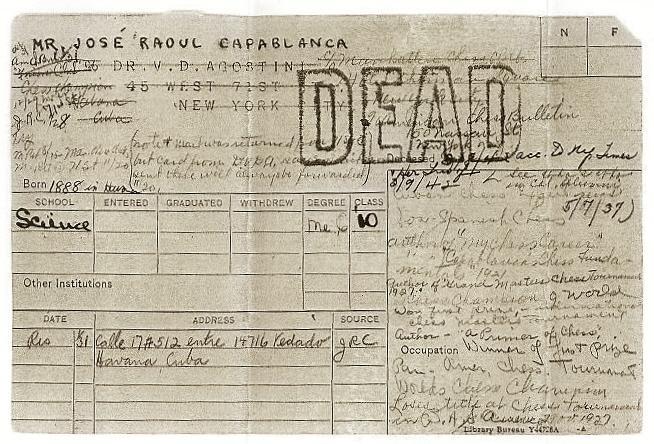
(6378)
The earliest Capablanca document in our collection is a copy of a three-page letter to his mother written when he was 17. It is given below in our translation from the Spanish. Pages 10-11 of our book on Capablanca quoted a report that his education in the United States was paid for by a Cuban businessman, Ramón San Pelayo, who became concerned that the youngster needed to apply himself to academic study rather than play chess.
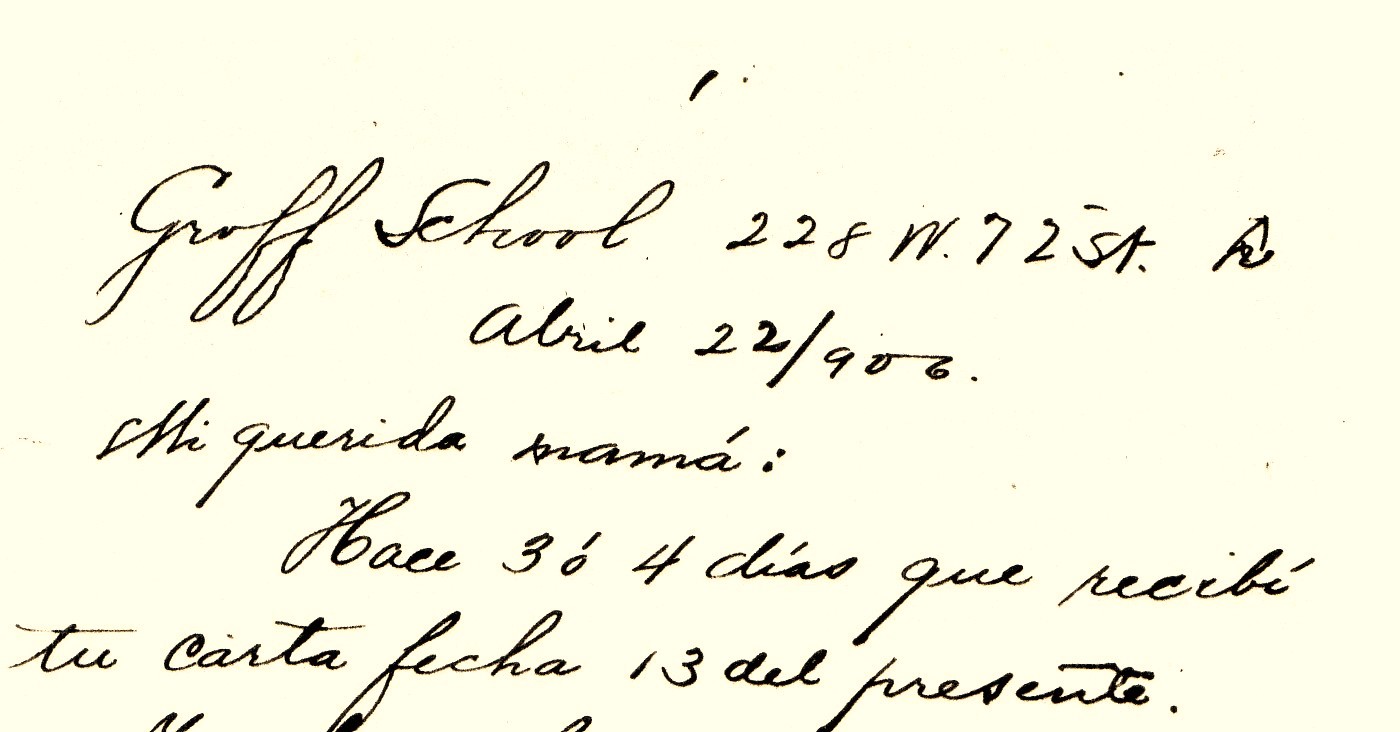
‘Groff School 228 W 72 St.
22 April 1906My dear mother,
Three or four days ago I received your letter of 13th of this month.
Now I can see what has been published in the Diario de la Marina. You or, rather, father can tell D. Ramón that three-quarters of the article is lies, and that while it is true that I played a simultaneous display and that the result was as the newspaper says, that was during the December vacation when I had nothing to do and no studying; as regards having had myself selected to play various simultaneous displays, none of that is true; it is correct that various club presidents have asked me to give simultaneous displays, even being willing to pay me for them, but I have always said that I could not do so because I had to study, and especially because I was prohibited from doing so. This is the pure truth, and if you wish you may show D. Ramón this letter.
Concerning the reports about me to D. Ramón, you can be sure that they are favorable, because the other day here the Director read out the fortnightly [or possibly two-monthly – Capablanca’s word bimensuales may mean either] results of the best pupils and said that I was the best, and by a long way, that although I had nine subjects, six of which were very difficult, I scored 85¾%, while the next one after me scored only 81% and did not have as many subjects, or such difficult ones, as I did. So you can see that you have nothing to worry about on that front.
Tell Nene that if possible he should be sure to send me a couple of cocos (pesos), as that would be very helpful when I am broke.
Goodbye; regards to everyone, my love to the children, and to you and to father an affectionate hug from your son, who thinks of you.
J. Raúl.’
(3333)
It should be noted that the above translation by us subsequently appeared – with a few minor differences and without permission – on page 99 of Miguel Sánchez’s book on Capablanca (Jefferson, 2015). Systematically, in that careless work Groff was misspelt ‘Graff’.
In June 2022, Yandy Rojas (Cárdenas, Cuba) sent us the article, by Juan Corzo, to which Capablanca had been referring in the letter to his mother. It appeared on page 6 of the morning edition of the Diario de la Marina, 7 April 1906:

In consideration of the foregoing, this C.N. item merits attention:
Carlos Alonso Mediavilla (Blanes, Spain) points out that the book Gent Nostra Capablanca by Marià Fontrodona (Edicions de Nou Art Thor, Barcelona, 1988) surprisingly states that Capablanca usually conversed with his mother not in Spanish but in Catalan. Here are the relevant passages from the book:
Page 3: ‘Josep Raül Capablanca i Graupera ostenta una nissaga plenament catalana, sense cap mena de dubte.’ Page 4: ‘El que reivindiquem aquí és la nissaga catalana de Josep Raül Capablanca i Graupera’. Page 5: ‘Des de la seva infantesa, el nostre personatge va parlar la llengua catalana, amb la seva mare i amb els familiars de la línia materna.’
(2374)
Yandy Rojas Barrios raises the topic of the 1906 rapid transit tournament at the Manhattan Chess Club, New York referred to by Capablanca towards the end of Chapter II (page numbers vary) of My Chess Career (London, 1920):
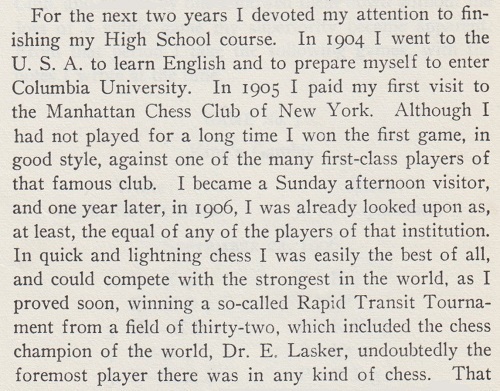
A reference to the tournament on page 35 of the February 1907 American Chess Bulletin was shown in C.N. 10421:

From page 8 of the Chicago Tribune, 20 January 1907:

On page 100 of The Unknown Capablanca by David Hooper and Dale Brandreth (London, 1975) the semi-final pairings against Davidson and Delmar were given the other way round:
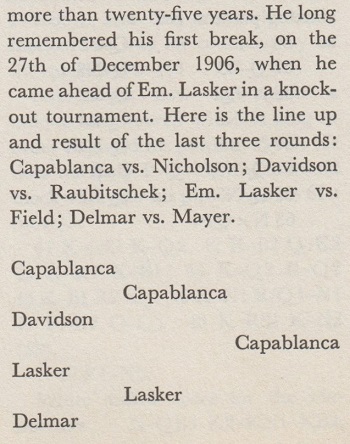
A later report on page 5 of the New York Evening Post, 23 January 1907:
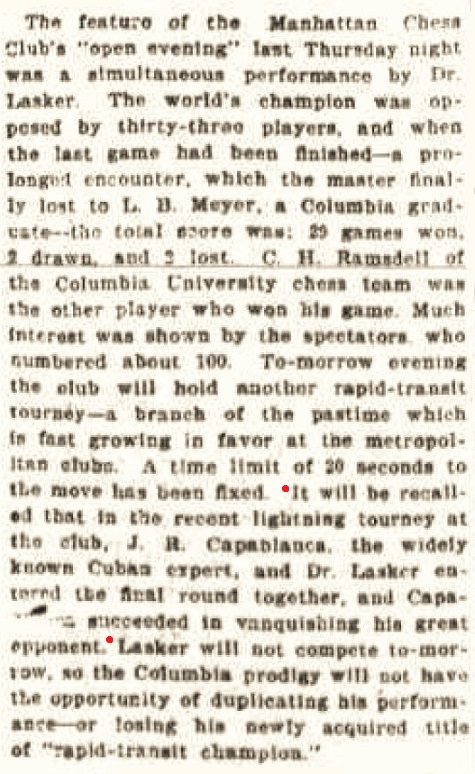
No earlier item in the Evening Post specifically on the December 1906 tournament has yet been found.
An assessment of Lasker and Capablanca was provided by Walter Penn Shipley on page 9 of the Philadelphia Inquirer, 20 January 1907:
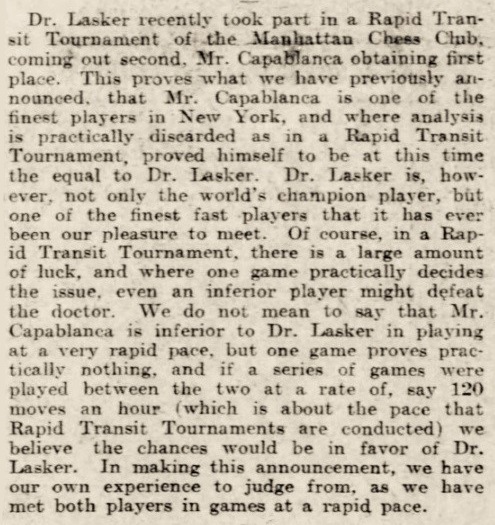
Mr Rojas Barrios notes that in secondary sources the tournament which brought together Lasker and Capablanca in December 1906 is sometimes misdated April 1906, one example being page 28 of El ajedrez en Cuba by José Luis Barreras Meriño (Havana, 2002):
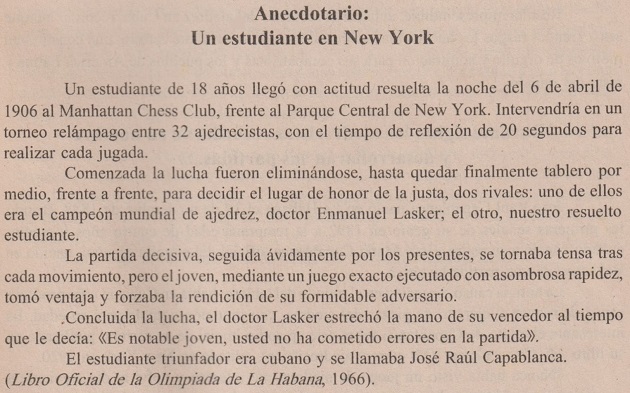
The source indicated (page 11 of the book on the Havana, 1966 Olympiad) had given no date for the rapid transit tournament:
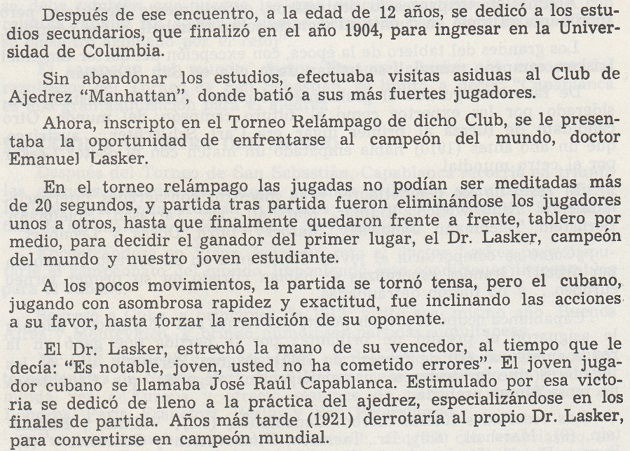
As our correspondent also points out, the April 1906 event was at the Rice Chess Club. From pages 61-63 of the April 1906 American Chess Bulletin:
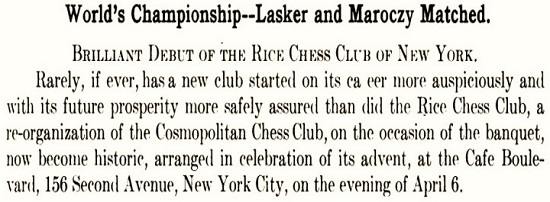

See too page 309 of our book on Capablanca.
C.N. 6077 noted that the remark by Lasker about Capablanca’s freedom from error, mentioned in the two Cuban books above, was supposedly made after their ten-game rapid transit match in Berlin in 1914.(11397)
An advertisement on page 16 of the South Orange Record, 22 April 1903:
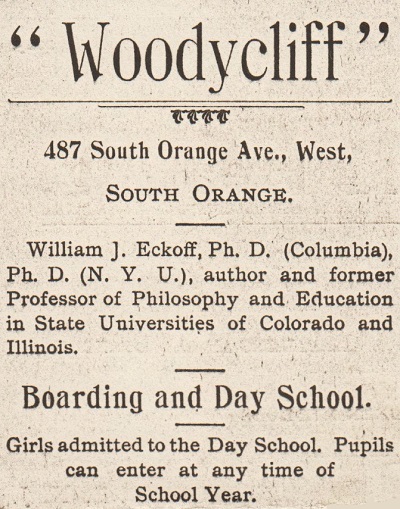
(11807)
Olimpiu G. Urcan (Singapore) sends a page from the Brooklyn Chess Club’s Visitors’ Book (1886-1928), the original of which is held by the Center for Brooklyn History. The entries relate to 24 November 1906, and, as regards the first of them, 1161 Amsterdam Avenue may be noted as a residence close to Columbia University.
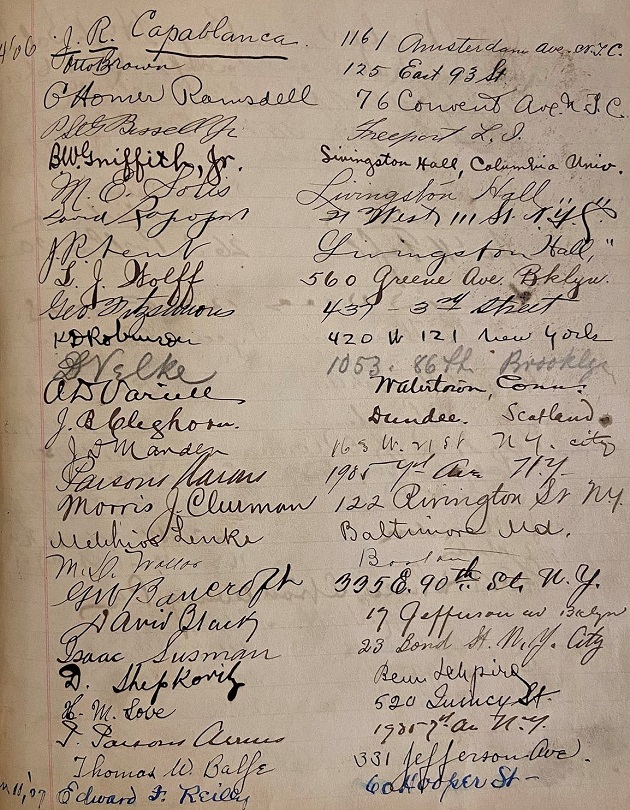
(11897)
Concerning a university chess opponent of Capablanca’s, Quincy A. Brackett, see C.N.s 6073, 6087, 7219 and 7220.
To the Chess Notes main page.
To the Archives for other feature articles.
Copyright: Edward Winter. All rights reserved.